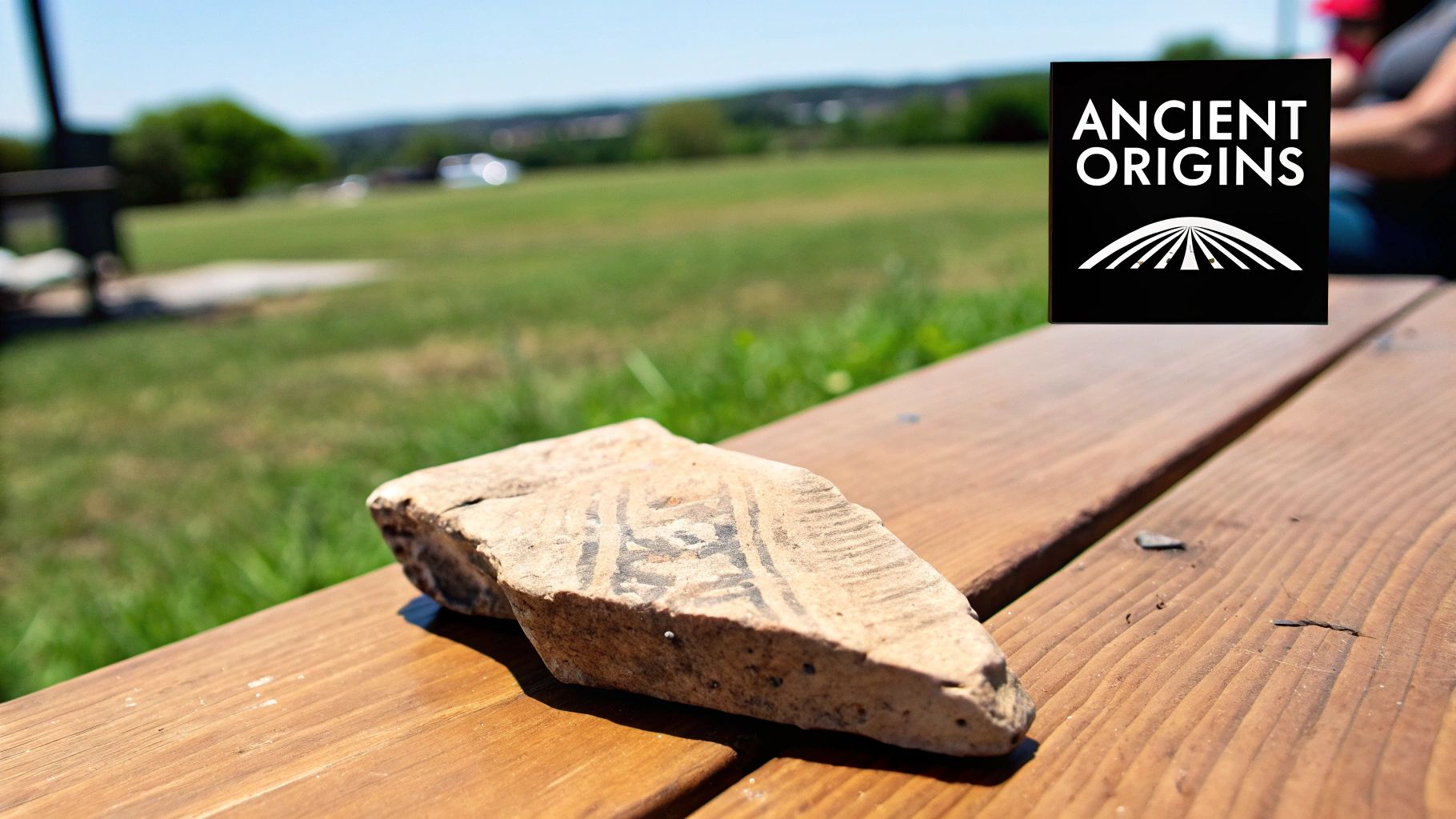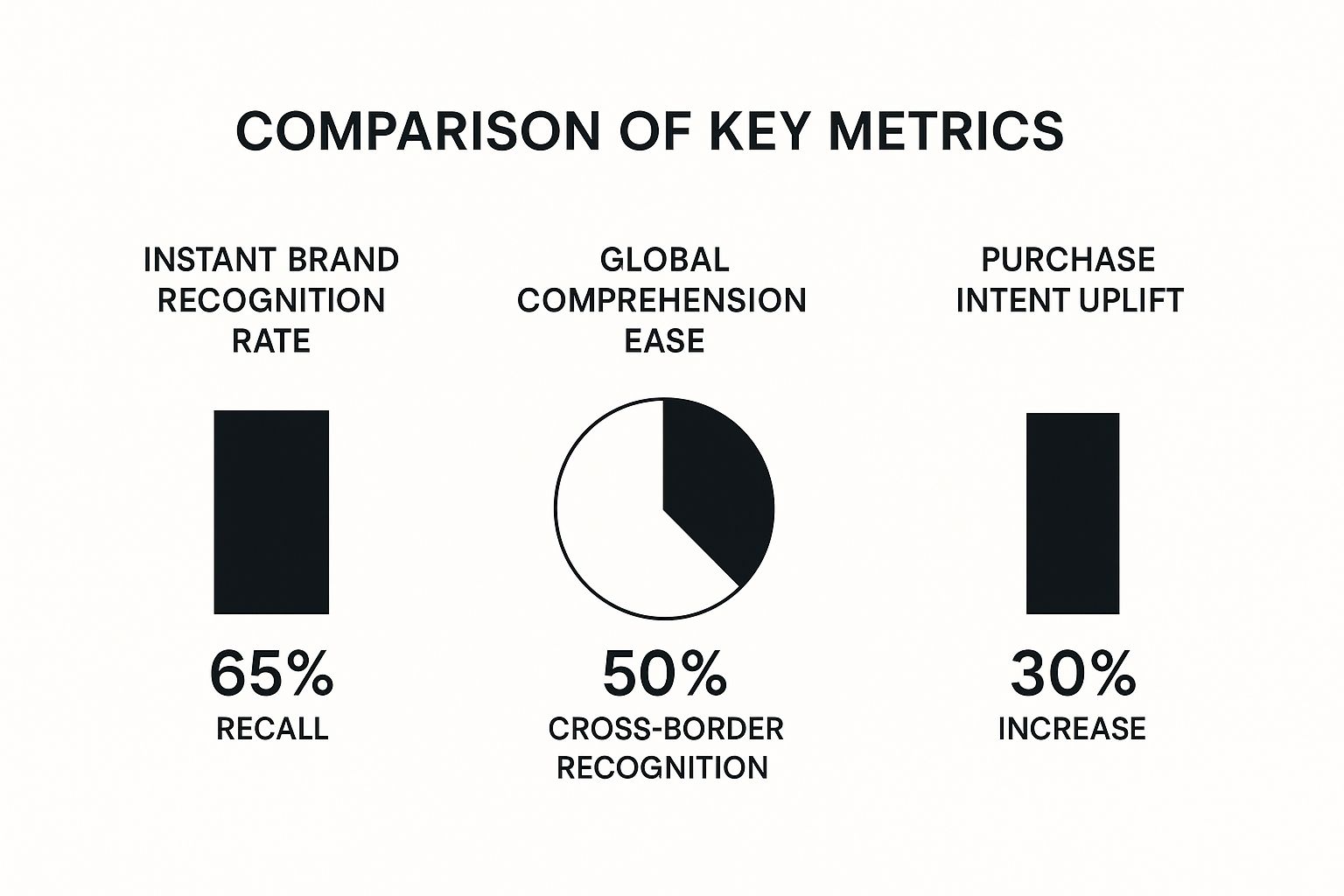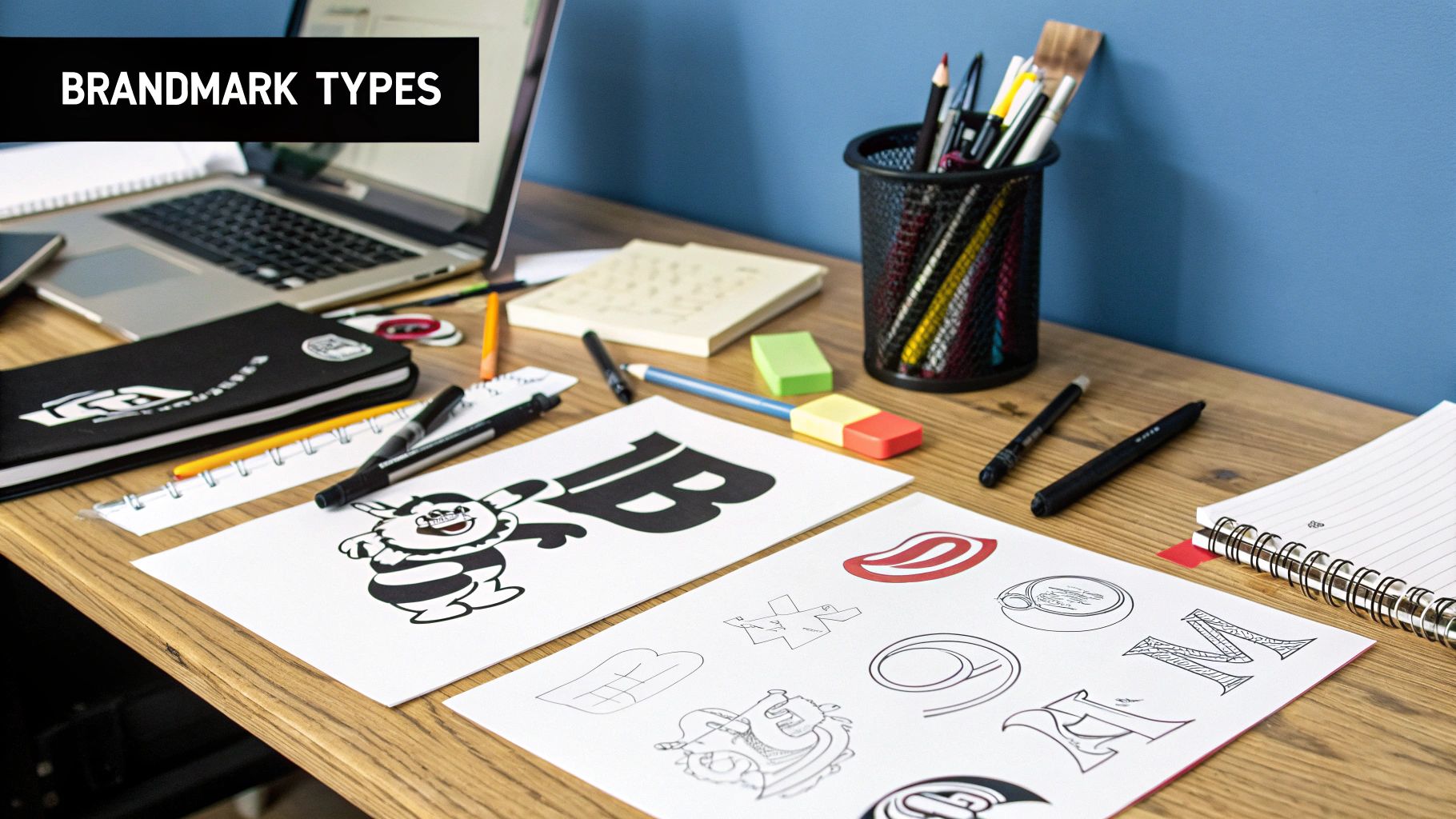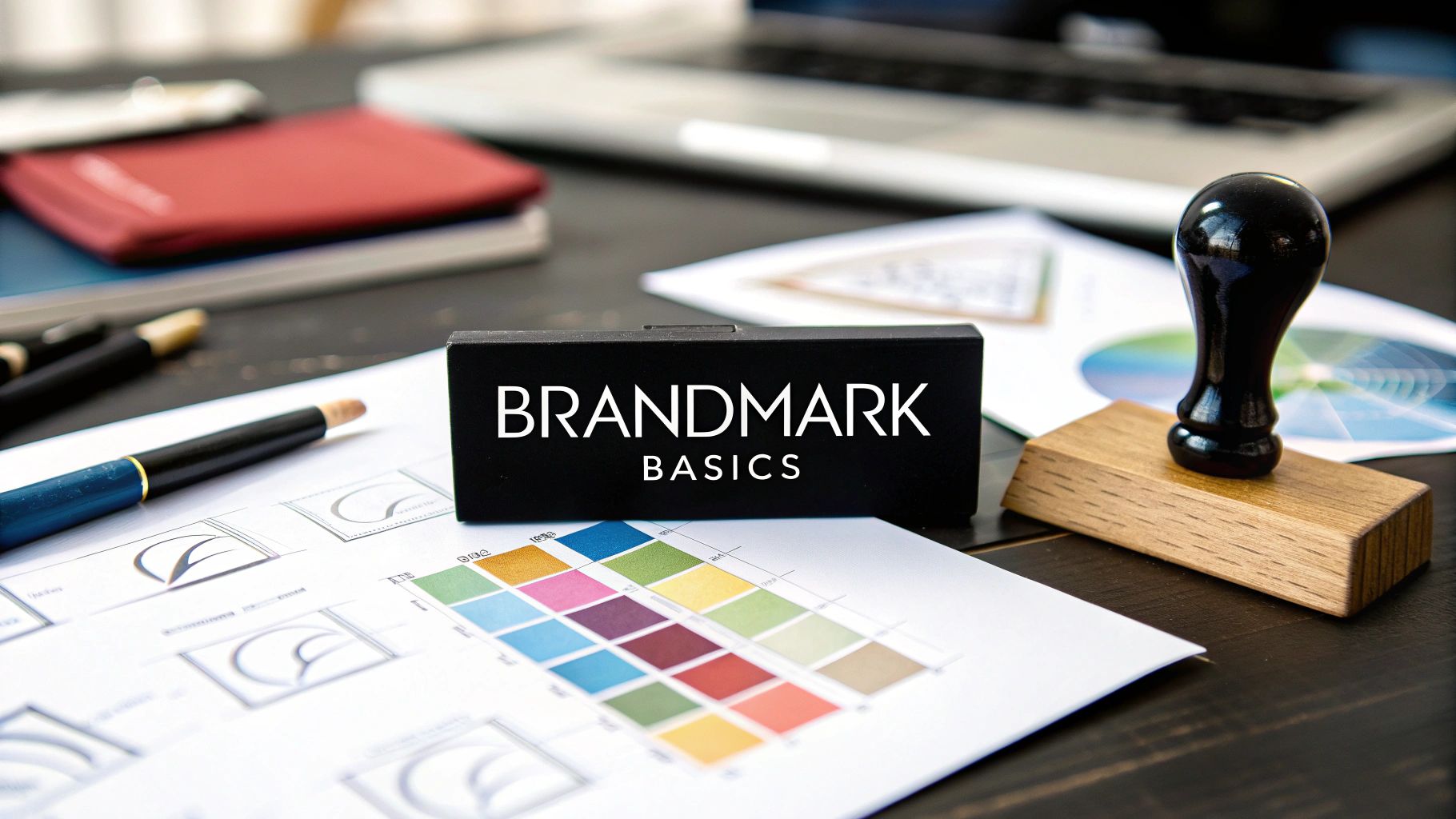A brandmark is that simple, powerful symbol that speaks for a company without saying a word. It's the visual shortcut to your brain. Think of the iconic Apple silhouette, the Nike swoosh, or the Target bullseye. It’s the part of a logo that aims for instant recognition, telling your brand’s story in a single glance.
The Foundation of Your Visual Identity

When you picture a famous company, what comes to mind first? For most of us, it’s not text—it’s a symbol. That symbol is the brandmark, and it’s the cornerstone of a company’s visual identity. It’s the purest, most distilled expression of a brand.
There’s a good reason for this. Our brains are hardwired to process images much faster than words. With around 65% of people identifying as visual learners, a strong brandmark is a potent tool for cutting through the noise. This visual shorthand helps a brand carve out its own space in a crowded market where every second of attention counts. For more great insights on creating the right symbol, AllTimeDesign.com is a fantastic resource.
What a Brandmark Is Not
To really get a handle on what a brandmark is, it helps to be clear on what it isn't. It’s easy to get these terms mixed up, but each piece of a logo has a specific job to do. To see how these elements all fit together, check out our guide on what are brand assets.
To break it down, let's look at the key differences.
Brandmark vs Logotype vs Combination Mark
This table shows how each element plays a unique role in building a brand's visual identity.
As you can see, while they often work together, the brandmark is the purely symbolic piece of the puzzle.
A brandmark is your company’s silent ambassador. It works 24/7, needs no translation, and builds an emotional connection with your audience faster than any slogan or mission statement ever could.
Ultimately, the dream for any brandmark is to become so recognizable that the company’s name isn’t even needed. That’s when you know you’ve got something truly iconic—when a simple symbol carries the full weight of your company's reputation, values, and promise.
How Brandmarks Evolved Through History

Brandmarks feel like a modern marketing invention, but their story actually starts thousands of years ago. They weren’t dreamed up in a fancy boardroom. Instead, they grew out of a basic human need to show ownership, quality, and origin with a quick, simple visual cue. Looking back at this history really highlights their timeless power.
The journey kicks off in ancient times. Picture artisans pressing a unique symbol into their pottery or stonework. While not a "logo" as we think of it today, it served a similar purpose. That specific mark on a clay pot told you exactly who made it, acting as an early seal of quality.
From Guild Seals to Corporate Symbols
This idea of a visual guarantee got more structured in the medieval era. Guilds—basically, early trade associations for craftsmen and merchants—started using special seals to certify their work. These seals were early brandmarks that promised a certain standard of quality and helped build trust. If you saw the guild’s seal, you knew you were getting the real deal.
The evolution of brandmarks shows a clear line from simple maker's marks, which primarily signified ownership, to complex corporate symbols that now represent a company's entire reputation and set of values.
This tradition of using marks to promise quality really set the stage for modern branding. It was a natural shift from simply saying "I made this" to saying "This was made to a high standard."
Then came the Industrial Revolution, and the need for these symbols skyrocketed. For the first time, goods were being mass-produced and sold far from where they were made. A simple, recognizable symbol on a package was the quickest way for a company to make its product stand out in a sea of competitors. This was the true beginning of the corporate brandmark.
The Digital Age and Symbolic Power
The 20th century and the rise of advertising poured fuel on the fire. Companies quickly learned that a symbol could pack a serious emotional punch and build a real connection with customers. The best ones became so iconic they didn't even need the company name next to them anymore.
Just think about the journey of a symbol like the Apple logo. It started as a complex illustration and was eventually refined into the simple, globally recognized mark we know today. You can learn more about this journey by reading our complete guide on the Apple company logo meaning and evolution.
This evolution is still happening. Today, a brandmark has to work just as well on a massive billboard as it does on a tiny app icon on your phone. Their long and rich history proves one simple truth: a powerful symbol is one of the most lasting and effective tools a business can ever have.
The Business Value of a Strong Brandmark
A great brandmark is so much more than a pretty graphic—it’s a silent salesperson, working 24/7 for your business. Think of it as a hard-working asset that continuously builds brand equity, creating real, tangible value that you can see on your bottom line.
In today's crowded world, whether it's on a store shelf or a social media feed, instant recognition is everything. A strong brandmark cuts right through that noise, helping customers spot you in a split second. That immediate recall is a huge competitive advantage.
Driving Recognition and Connection
A well-designed symbol instantly tells people who you are and what you stand for. It’s a shortcut to your company's personality, creating an emotional connection that can turn a one-time buyer into a lifelong fan. This visual handshake is often the very first step in building a lasting relationship with a customer.
Symbols also have an incredible ability to cross language and cultural lines. For brands that operate globally, a brandmark sends the same clear message in every country, creating a universal identity without ever needing a translator.
The data below shows just how much a strong brandmark can influence key business metrics like recognition, global reach, and a customer's willingness to buy.

The numbers don't lie. A memorable brandmark directly boosts customer recall and makes them far more likely to choose your product over a competitor's. This visual asset is foundational to building a strong financial future for your company. To dig deeper into this, check out our guide on how to measure brand value: https://www.softriver.co/blog/brand-value-measurement-your-complete-strategy-guide.
Building Long-Term Trust and Consistency
At its core, a brandmark is a promise of consistency. Every time a customer sees that symbol, it reinforces their experiences with your company, building a foundation of trust over time. Applying it consistently is what keeps your image professional and reliable.
A brandmark isn’t just what you see; it’s what you feel. It’s the condensed story of your company, its values, and its promise to the customer, delivered in a single, memorable moment.
To make sure your brandmark is always used correctly and maintains its power, it's essential to create effective brand guidelines. This simple document ensures everyone, from your marketing team to outside vendors, uses the symbol correctly, protecting its integrity and value.
This one visual element has a direct and powerful influence on whether someone buys from you. It gives customers confidence in their choice, makes their decision-making easier, and sets the stage for genuine, long-term loyalty. Investing in a professional brandmark isn't just an expense—it's an investment in the perception, growth, and lasting success of your business.
Finding the Right Type of Brandmark

Choosing a brandmark isn’t just about picking a symbol that looks cool. It’s a strategic move that fundamentally shapes how people see your company. Different types of brandmarks have their own superpowers, and the best one for you hinges entirely on your brand's personality, your industry, and what you’re trying to achieve.
Getting to know the main categories is the first step toward making a smart choice. Each one speaks a different visual language, from the literal and straightforward to the purely conceptual. Let's break down the three most common types you’ll encounter.
Pictorial Marks: The Literal Connection
A pictorial mark uses a recognizable, real-world object to represent the brand. It’s a direct and simple image that often has an obvious tie to the company’s name or what it does. Just think of Apple's bitten apple or Target's bullseye—the connection is instant.
These brandmarks are fantastic for creating straightforward associations in a customer's mind.
- When to use them: They’re a great fit when your company name is linked to a physical object, making the visual connection clear and memorable.
- The biggest benefit: People get them right away. This simplicity helps build brand recognition quickly without needing a long backstory.
The trick, however, is to pick an image that's distinct enough to stand out and won't box you in if your business decides to branch out later on.
Abstract Marks: The Conceptual Idea
Unlike their pictorial cousins, abstract brandmarks are conceptual forms that don't represent any specific object from the real world. Instead, they’re crafted to evoke a feeling, an idea, or a core value. The Nike swoosh, for example, is all about motion and speed, while the Pepsi globe feels dynamic and global.
An abstract brandmark is a powerful choice for technology companies and global corporations because it can communicate complex ideas like innovation, connection, or trust without being tied to a single, literal image.
This approach gives you a completely unique visual—a shape that belongs to you and you alone. It opens the door to building a powerful story around a symbol that nobody else has. To see how different industries use visuals, checking out inspiring construction company logos can show you how various brandmark types make an impact.
Mascots: The Personable Face
Mascots literally give your brand a face and a personality. These illustrated characters, like the Michelin Man or KFC's Colonel Sanders, are designed to be friendly, approachable, and relatable. They are brilliant at forging a strong emotional connection, especially with families and wider consumer audiences.
A mascot can act as a brand ambassador, engaging with customers in commercials, on packaging, and across social media. They are perfect for brands that want to cultivate a warm, community-driven identity. The challenge is creating a character that genuinely reflects your brand's spirit and will stay relevant and beloved for years to come.
Choosing the Right Brandmark Type for Your Business
Feeling a bit stuck on which direction to go? It's a common hurdle. Each brandmark type serves a different strategic purpose, and what works for a playful food brand might not suit a serious financial firm. This table breaks down the core strengths of each to help you match a style to your business goals.
Ultimately, the right choice connects your brand's essence to your audience in the most direct and memorable way possible. Consider your long-term vision—will this symbol grow with you, or will it hold you back? Thinking about that now will save you a world of trouble down the line.
Iconic Brandmarks and Their Hidden Stories
https://www.youtube.com/embed/HovT-6Zel2o
The best brandmarks in the world are more than just pretty pictures. They’re packed with meaning, clever details, and fascinating backstories that make them instantly recognizable. When you dig into these stories, you start to see the genius at work—the strategic thinking that turns a simple image into a cultural icon.
Think of these symbols as a visual shortcut. They communicate a brand’s entire mission in the blink of an eye. Let’s pull back the curtain on the hidden brilliance behind a few brandmarks you probably see every day.
The FedEx Arrow of Speed
At first glance, the FedEx logo looks simple enough—just the company name in a bold, clean font. But take a closer look at the space between the “E” and the “x.” See it? There’s a perfect arrow pointing to the right, a subtle nod to speed, forward momentum, and getting things where they need to go.
This hidden arrow is a masterclass in design. It’s not in your face, which makes spotting it a fun little "aha!" moment. This clever detail reinforces the company’s core promise without having to spell it out, building a quiet, subconscious link to efficiency and reliability.
A truly great brandmark doesn't just show you what a company does; it makes you feel it. The FedEx arrow is a perfect example of design that communicates a core value in a clever, almost secret way.
The design's subtlety is its true power. It’s won over 40 design awards and is consistently ranked as one of the best logos ever created. It’s proof that sometimes the most powerful messages are whispered, not shouted.
The Amazon Smile from A to Z
Amazon’s brandmark is another fantastic example of simple, powerful storytelling. That friendly orange swoosh under the name is doing two jobs at once. First, it’s a smile, which immediately makes you think of customer satisfaction and a happy shopping experience.
But the arrow’s placement is equally brilliant. It stretches from the letter “a” to the letter “z,” a clear visual cue that Amazon sells everything you can think of, from A to Z. In one smooth curve, this brandmark captures two of the company’s biggest promises: an incredible selection and a commitment to customer happiness.
The Starbucks Siren's Call
The Starbucks siren, with her mysterious two-tailed design, is rooted in mythology and a sense of adventure. The founders wanted a name and symbol that evoked the seafaring history of their hometown, Seattle, and the exotic journey of coffee beans from around the world. The siren, a creature from Greek myths who lured sailors to shore with her irresistible song, felt like the perfect fit.
She symbolizes the alluring, almost magnetic pull of a great cup of coffee. The siren connects the brand to a grander story of exploration and discovery, inviting customers to be drawn in. While the design has been simplified over the years, the siren remains the heart of the brand—a symbol of history, mystery, and temptation.
As you can see, a great brandmark is so much more than a logo. It’s a story, a promise, and sometimes, a fun little puzzle. These examples show how a bit of creative thinking can turn a simple image into a legendary symbol that truly lasts.
Common Questions About Brandmarks
So, we've covered the basics, but I know from experience that this is where the real-world questions start popping up. Let's tackle some of the most common things people ask when they're actually in the trenches, working on a brandmark.
Think of this as your go-to cheat sheet for navigating those tricky, practical details.
Can a Brandmark Change Over Time?
You bet it can. In fact, it should evolve. Brands often tweak their brandmarks to keep things fresh, connect with a new generation of customers, or show the world they're heading in a new direction. It’s just part of a healthy brand lifecycle.
Take Apple. Their original logo was a detailed, rainbow-striped drawing of Isaac Newton. Can you imagine that on an iPhone today? They evolved into the clean, iconic apple we all recognize. The trick is to evolve thoughtfully. A gentle refresh that keeps the soul of the original is usually a much smarter move than a radical change that leaves your loyal fans scratching their heads.
The goal of a brandmark evolution is to modernize without losing recognition. It's a delicate balance between staying current and honoring the brand equity you've already built.
Is a Brandmark Legally Protected?
Yes, and please don't skip this step. You absolutely should protect your brandmark by registering it as a trademark.
This process gives you the exclusive legal right to use that symbol for what you do. Even more importantly, it gives you the legal firepower to stop another company from using a similar mark that could confuse your customers.
- What it protects: The specific visual design of your symbol.
- Why it's essential: It's your primary defense against copycats and brand confusion.
- The outcome: Your design stops being just a creative asset and becomes a legally defensible business asset.
Without trademark protection, you're leaving the door wide open for someone else to dilute the unique identity you’ve worked so hard to build.
Do I Need a Brandmark If My Company Name Is Strong?
It's not a legal requirement, but I highly recommend it. A great name is a fantastic foundation, but a symbol does things that words alone just can't.
Our brains are wired for visuals—we process images about 60,000 times faster than text. That means a brandmark can get you instant recognition in situations where a name would be too slow or too clunky. It's also incredibly flexible. Think about all the tiny spaces it needs to work in: social media profile pictures, app icons, and those little favicons in your browser tabs. A full company name would be a blurry mess.
Plus, a symbol speaks a universal language, which is a massive advantage for any brand with global ambitions. A powerful brandmark doesn't replace your name; it elevates it, creating a more memorable, versatile, and stronger identity overall.
Ready to create a brandmark that tells your story and captures your audience? The expert designers at Softriver craft timeless, custom brand identities that set you up for success. Learn more about our process and get started at https://softriver.co.







